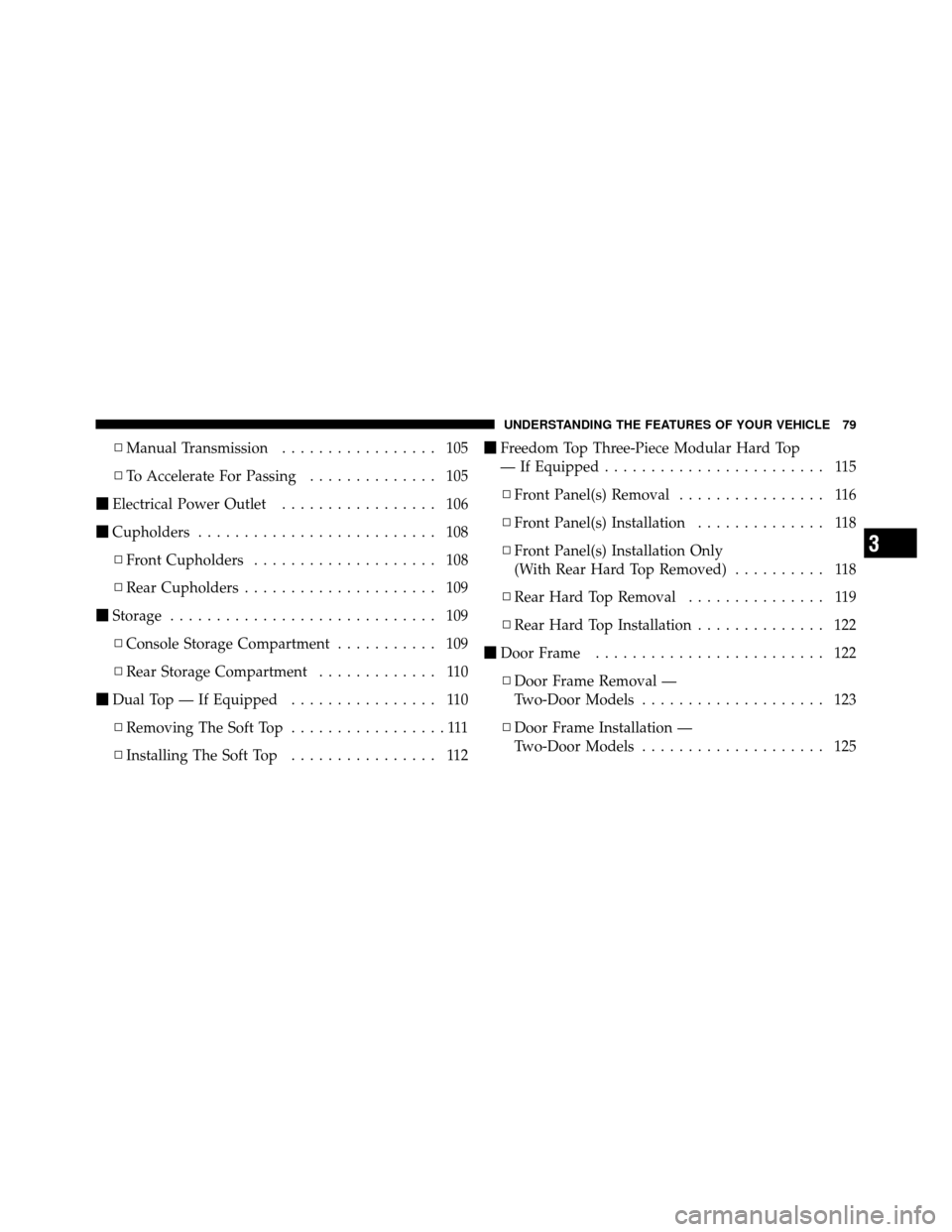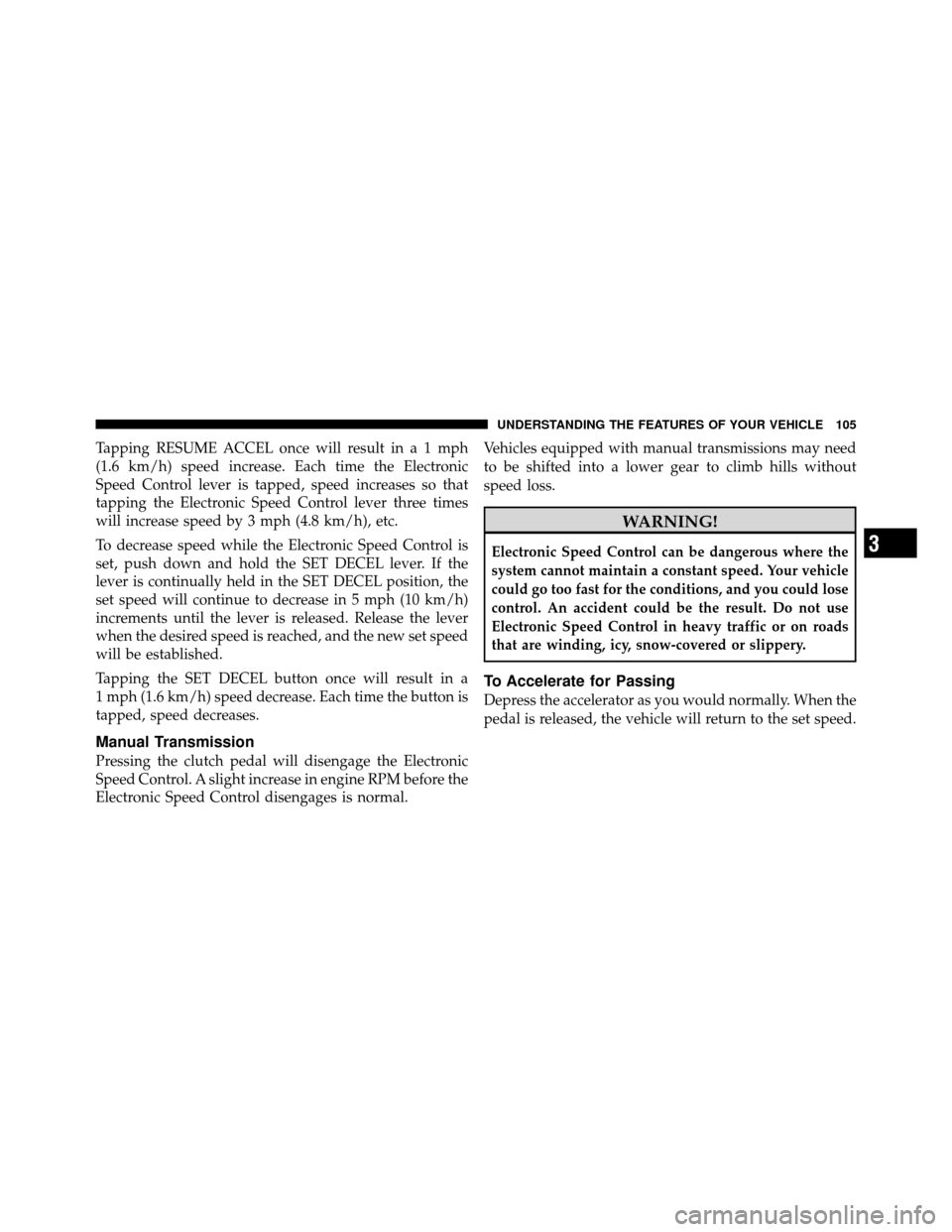Page 15 of 502

Manual Transmission — If Equipped
1. Turn the ignition switch to the ACC (ACCESSORY)
position.
2. Push the ignition key inward.
3. Turn the ignition key to the LOCK position, and
remove the key.
WARNING!
Leaving unattended children in a vehicle is danger-
ous for a number of reasons. A child or others could
be injured. Children should be warned not to touch
the parking brake, brake pedal, or the shift lever. Do
not leave the key in the ignition. A child could
operate power windows, other controls, or move the
vehicle.
CAUTION!
An unlocked vehicle is an invitation to thieves.
Always remove the key from the ignition, and lock
all doors when leaving the vehicle unattended.
Key-In-Ignition Reminder
Opening the driver’s door when the key is in the ignition,
sounds a signal to remind you to remove the key.
STEERING WHEEL LOCK
Your vehicle may be equipped with a passive steering
wheel lock. This lock prevents steering the vehicle with-
out the ignition key. If the steering wheel is moved
approximately a half turn in either direction, and the key
is not in the ignition, the steering wheel will lock.
2
THINGS TO KNOW BEFORE STARTING YOUR VEHICLE 13
Page 81 of 502

▫Manual Transmission ................. 105
▫ To Accelerate For Passing .............. 105
� Electrical Power Outlet ................. 106
� Cupholders .......................... 108
▫ Front Cupholders .................... 108
▫ Rear Cupholders ..................... 109
� Storage ............................. 109
▫ Console Storage Compartment ........... 109
▫ Rear Storage Compartment ............. 110
� Dual Top — If Equipped ................ 110
▫ Removing The Soft Top .................111
▫ Installing The Soft Top ................ 112 �
Freedom Top Three-Piece Modular Hard Top
— If Equipped ........................ 115
▫ Front Panel(s) Removal ................ 116
▫ Front Panel(s) Installation .............. 118
▫ Front Panel(s) Installation Only
(With Rear Hard Top Removed) .......... 118
▫ Rear Hard Top Removal ............... 119
▫ Rear Hard Top Installation .............. 122
� Door Frame ......................... 122
▫ Door Frame Removal —
Two-Door Models .................... 123
▫ Door Frame Installation —
Two-Door Models .................... 125
3
UNDERSTANDING THE FEATURES OF YOUR VEHICLE 79
Page 107 of 502

Tapping RESUME ACCEL once will result ina1mph
(1.6 km/h) speed increase. Each time the Electronic
Speed Control lever is tapped, speed increases so that
tapping the Electronic Speed Control lever three times
will increase speed by 3 mph (4.8 km/h), etc.
To decrease speed while the Electronic Speed Control is
set, push down and hold the SET DECEL lever. If the
lever is continually held in the SET DECEL position, the
set speed will continue to decrease in 5 mph (10 km/h)
increments until the lever is released. Release the lever
when the desired speed is reached, and the new set speed
will be established.
Tapping the SET DECEL button once will result in a
1 mph (1.6 km/h) speed decrease. Each time the button is
tapped, speed decreases.
Manual Transmission
Pressing the clutch pedal will disengage the Electronic
Speed Control. A slight increase in engine RPM before the
Electronic Speed Control disengages is normal.Vehicles equipped with manual transmissions may need
to be shifted into a lower gear to climb hills without
speed loss.
WARNING!
Electronic Speed Control can be dangerous where the
system cannot maintain a constant speed. Your vehicle
could go too fast for the conditions, and you could lose
control. An accident could be the result. Do not use
Electronic Speed Control in heavy traffic or on roads
that are winding, icy, snow-covered or slippery.
To Accelerate for Passing
Depress the accelerator as you would normally. When the
pedal is released, the vehicle will return to the set speed.
3
UNDERSTANDING THE FEATURES OF YOUR VEHICLE 105
Page 218 of 502

Automatic Compass Calibration
The self-calibrating feature of the compass eliminates the
need to calibrate the compass for normal conditions.
During a short initial period, the compass may appear
erratic and the CAL symbol will appear (blinking) on the
display. After the vehicle has completed at least one
complete circle under 5 mph (8 km/h) in an area free
from large metal objects, calibration will be complete
when the CAL symbol is extinguished.
After initial calibration, the compass will continue to
automatically update this calibration whenever the ve-
hicle is in motion.
Manual Compass Calibration
NOTE: Before attempting a manual compass calibra-
tion, the engine must be running and the transmission
in the PARK position (if equipped).If the compass appears erratic or inaccurate and the
variance has been properly set, you may wish to manu-
ally recalibrate the compass. To manually calibrate the
compass:
1. First enter the variance mode. Press and hold the left
button (located on the instrument cluster) for approxi-
mately 10 seconds to enter the variance mode, and
release the button when the VAR (Compass Variance)
symbol appears.
2. The current variance value will also be displayed.
Once in the variance mode, it is necessary to release the
button, and then press and hold it again (approximately
10 seconds) until CAL is displayed (solid, not blinking).
216 UNDERSTANDING YOUR INSTRUMENT PANEL
Page 275 of 502
STARTING AND OPERATING
CONTENTS
�Starting Procedures .................... 277
▫ Manual Transmission ................. 277
▫ Automatic Transmission ............... 277
▫ Normal Starting ..................... 277
▫ Extreme Cold Weather
(Below –20°F Or –29°C) ................ 278
▫ If Engine Fails To Start ................ 278
▫ After Starting ....................... 280
� Engine Block Heater — If Equipped ........ 281�
Manual Transmission — If Equipped ........ 281
▫ Shifting ........................... 282
▫ Downshifting ....................... 283
▫ Reverse Shifting ..................... 284
� Automatic Transmission — If Equipped ...... 285
▫ Key Ignition Park Interlock ............. 285
▫ Brake/Transmission Interlock System ...... 286
▫ Brake/Transmission Interlock Manual
Override .......................... 286
5
Page 279 of 502

STARTING PROCEDURES
Before starting your vehicle, adjust your seat, adjust both
inside and outside mirrors, and fasten your seat belts.
WARNING!
Do not leave children or animals inside parked
vehicles in hot weather. Interior heat buildup may
cause serious injury or death.
Manual Transmission
Apply the parking brake, place the shift lever in NEU-
TRAL, and press the clutch pedal before starting the
vehicle. This vehicle is equipped with a clutch interlock-
ing ignition system. It will not start unless the clutch
pedal is pressed to the floor.
Four-Wheel Drive Models Only
In 4L mode, this vehicle will start regardless of whether
or not the clutch pedal is pressed to the floor. This featureenhances off-road performance by allowing the vehicle to
start when in 4L without having to press the clutch pedal.
The “4WD Indicator Light” will illuminate when the
transfer case has been shifted into this mode.
Automatic Transmission
Start the engine with the shift lever in the NEUTRAL or
PARK position. Apply the brake before shifting to any
driving range.
Normal Starting
NOTE:
Normal starting of either a cold or a warm
engine is obtained without pumping or pressing the
accelerator pedal.
Turn the ignition switch to the START position and
release when the engine starts. If the engine fails to start
within 10 seconds, turn the ignition switch to the LOCK
position, wait 10 to 15 seconds, then repeat the “Normal
Starting” procedure.
5
STARTING AND OPERATING 277
Page 281 of 502

WARNING! (Continued)
•Do not attempt to push or tow your vehicle to get
it started. Vehicles equipped with an automatic
transmission cannot be started this way. Unburned
fuel could enter the catalytic converter and, once
the engine has started, ignite and damage the
converter and vehicle. If the vehicle has a dis-
charged battery, booster cables may be used to
obtain a start from a booster battery or the battery
in another vehicle. This type of start can be dan-
gerous if done improperly. Refer to Section 6 of
this manual for proper jump starting procedures
and follow them carefully.
Without Tip Start — Manual Transmission Only
If the engine fails to start after you have followed the
“Normal Starting” or “Extreme Cold Weather” proce-
dures, it may be flooded. Push the accelerator pedal all the way to the floor and hold it there while cranking the
engine. This should clear any excess fuel in case the
engine is flooded.
CAUTION!
To prevent damage to the starter, do not crank the
engine for more than 15 seconds at a time. Wait 10 to
15 seconds before trying again.
If the engine has been flooded, it may start to run, but not
have enough power to continue running when the key is
released. If this occurs, continue cranking with the accel-
erator pedal pushed all the way to the floor. Release the
accelerator pedal and the key once the engine is running
smoothly.
5
STARTING AND OPERATING 279
Page 283 of 502

ENGINE BLOCK HEATER — IF EQUIPPED
The engine block heater warms the engine, and permits
quicker starts in cold weather. Connect the cord to a
standard 110-115 Volt AC electrical outlet with a
grounded, three-wire extension cord. The engine block
heater cord is found under the hood bundled in front of
the battery tray.
WARNING!
Remember to disconnect the cord before driving.
Damage to the 110-115 Volt AC electrical cord could
cause electrocution.
Use the heater when temperatures below 0°F (-18°C) are
expected to last for several days.
MANUAL TRANSMISSION — IF EQUIPPED
WARNING!
You or others could be injured if you leave the
vehicle unattended without having the parking
brake fully applied. The parking brake should al-
ways be applied when the driver is not in the vehicle,
especially on an incline.
CAUTION!
Never drive with your foot resting on the clutch
pedal, or attempt to hold the vehicle on a hill with the
clutch pedal partially engaged, as this will cause
abnormal wear on the clutch.
5
STARTING AND OPERATING 281